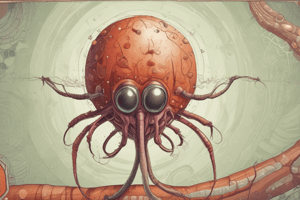Podcast
Questions and Answers
What is the primary purpose of the Leishmanin (Montenegro) I.D.test in the diagnosis of cutaneous leishmaniasis?
What is the primary purpose of the Leishmanin (Montenegro) I.D.test in the diagnosis of cutaneous leishmaniasis?
- To detect the presence of antibodies against leishmania
- To identify the species of leishmania
- To confirm the diagnosis of cutaneous leishmaniasis (correct)
- To determine the severity of the infection
What is the characteristic of Leishmania amastigote?
What is the characteristic of Leishmania amastigote?
- Elongate, slender and measure about 10-12 µm
- Flagellum arises at the posterior end
- Washed promastigotes solution in 5% phenol
- Spherical to ovoid and measure 1-5 µm (correct)
What is the method of Leishmanin (Montenegro) I.D.test?
What is the method of Leishmanin (Montenegro) I.D.test?
- Oral administration of 2 ml antigen
- Intramuscular injection of 1 ml antigen in the thigh
- Subcutaneous injection of 0.5 ml antigen in the arm
- Intradermal injection of 0.1 ml antigen in the forearm (correct)
What is the purpose of Isoenzyme analysis in the diagnosis of leishmaniasis?
What is the purpose of Isoenzyme analysis in the diagnosis of leishmaniasis?
What is the recommended treatment for diffuse cutaneous leishmaniasis?
What is the recommended treatment for diffuse cutaneous leishmaniasis?
What is the common method of control of sandfly in the control of leishmaniasis?
What is the common method of control of sandfly in the control of leishmaniasis?
What is the characteristic of Leishmania promastigote?
What is the characteristic of Leishmania promastigote?
What is the purpose of PCR in the diagnosis of leishmaniasis?
What is the purpose of PCR in the diagnosis of leishmaniasis?
What is the recommended treatment for simple sores in cutaneous leishmaniasis?
What is the recommended treatment for simple sores in cutaneous leishmaniasis?
What is the purpose of health education in the control of leishmaniasis?
What is the purpose of health education in the control of leishmaniasis?
Flashcards are hidden until you start studying
Study Notes
Leishmaniasis
- Caused by failure of cell-mediated immunity
- Immunoglobulin antibodies increase only in visceral leishmaniasis
Effect of Temperature
- Species causing cutaneous lesions cannot grow at core body temperature, but visceral species can
Old World Cutaneous Leishmaniasis
- Endemic in Mediterranean region, Turkey, North and West Africa, Middle and South Asia
- Confined to skin, especially face and limbs
- Occasionally extends to mucous membrane of mouth, producing mucocutaneous lesions
Pathogenesis and Clinical Manifestations
- Promastigotes change to amastigotes, which are rapidly phagocytosed by macrophages
- Parasites replicate, cells rupture, and then invade other cells
- Granulomatous reaction leads to formation of:
- Nodule at site of inoculation, which crusts and then ulcerates
- Chronic ulcer with elevated, indurated edges
- Healing gradually in 2-10 months, leaving a depigmented scar with small nodules at the edge
- Secondary bacterial infection
Leishmania tropica Complex
- Includes L. tropica, L. major, and L. aethiopica
- L. tropica:
- Geographically distributed in Mediterranean region, Middle East, South Russia, and India
- Clinically, it causes a painless ulcer with raised margins, usually affecting face and exposed parts of the body
Morphology and Life Cycle
- Amastigotes in vertebrate host (man and animal)
- Promastigote in arthropode vector (sandfly in old world and Lutzomyia in new world)
- Reservoir hosts: rodents, foxes, and dogs
Mode of Infection (Transmission)
- Biological by the bite of vector containing the infective stage (promastigotes)
- Mechanical by direct contact with ulcerating lesions containing amastigotes
- Blood transfusion in visceral leishmaniasis
Immune Response
- Immunity is mainly cellular (not entirely beneficial, can cause granulomas and tissue destruction)
- According to immune system, one of three events occurs:
- Parasites are killed by immune response, and person becomes immune to reinfection
- Local infection is established, which persists until immune response eradicates it or is overwhelmed, permitting dissemination
- Infection metastasizes through blood to viscera (viscerotropic species), oronasal mucosa (mucocutaneous species), or skin
Laboratory Diagnosis
- Leishmanin (Montenegro) I.D. test:
- Antigen: washed promastigotes solution in 5% phenol on saline
- Method: intradermal injection of 0.1 ml antigen in forearm à induration after 48 hours
- Identification of species of Leishmania:
- Isoenzyme analysis
- PCR
Treatment
- Local (for simple sores):
- Excision for small facial lesions
- Curettage under local anesthesia
- Heat for 39-41°C for many hours for several days
- Cryotherapy using liquid nitrogen or carbon dioxide snow
- Drugs: aminosidine (Paromomycin) ointment or Pentavalent antimony (Pentostam) injections in the edge of the ulcer
- Systemic:
- Pentavalent antimony (Pentostam): 10 mg/Kg I.M. daily for 10 days
- Amphotericine B (Fungizone)
Control of Leishmaniasis
- Treatment of cases
- Eradication of reservoir animals
- Control of sandfly using insecticides
- Mosquito’s nets and screens
- Use of repellents as citronella oil in endemic areas
- Health education
Studying That Suits You
Use AI to generate personalized quizzes and flashcards to suit your learning preferences.




